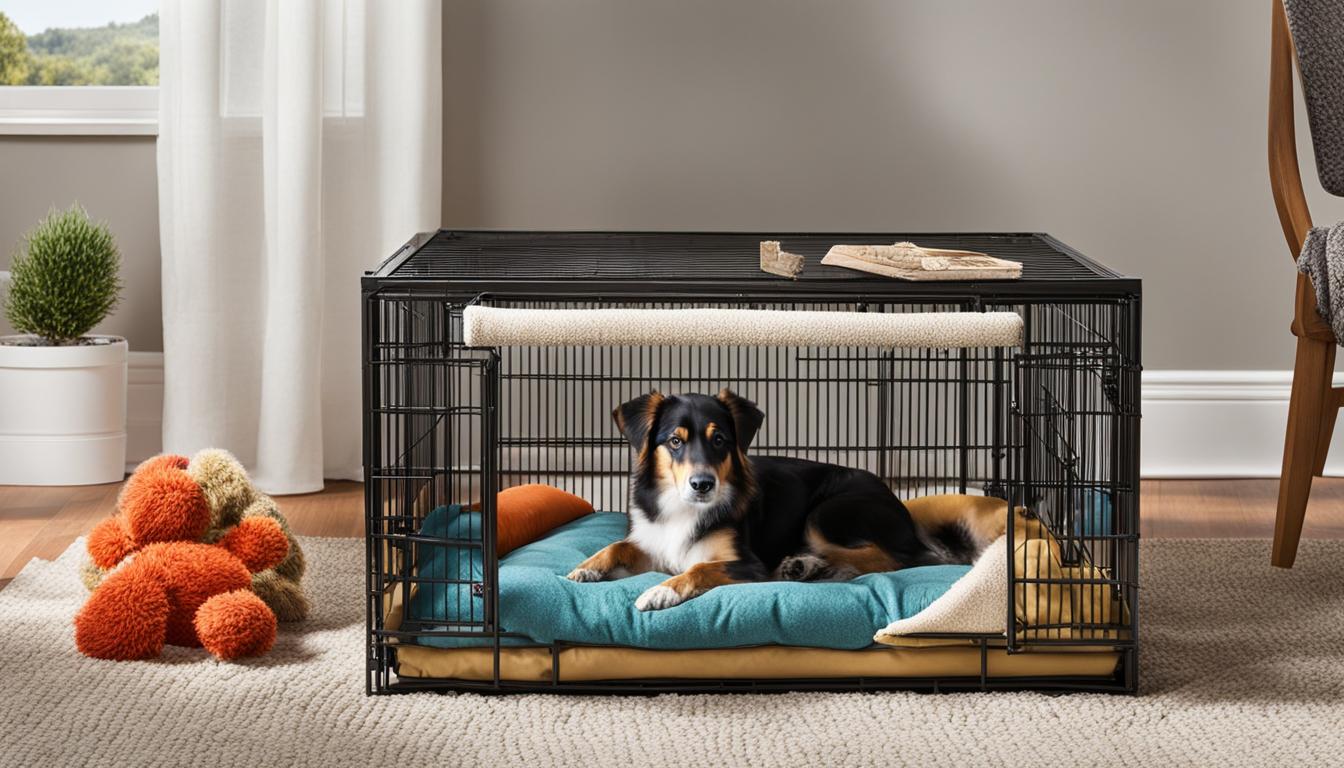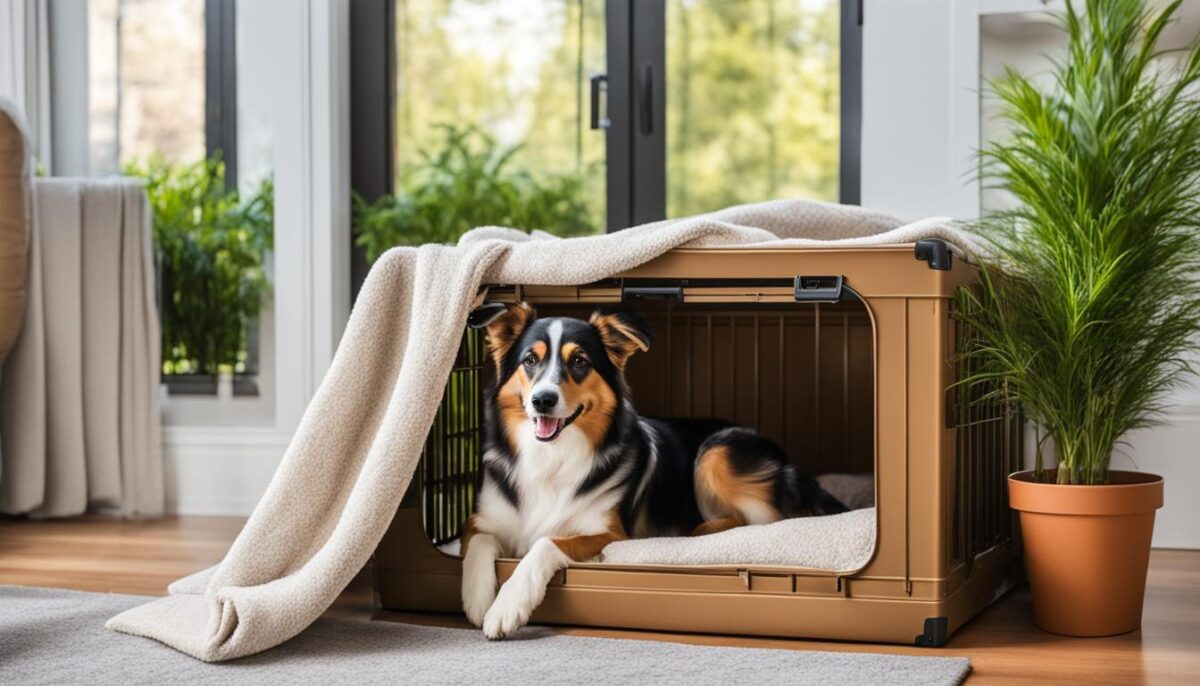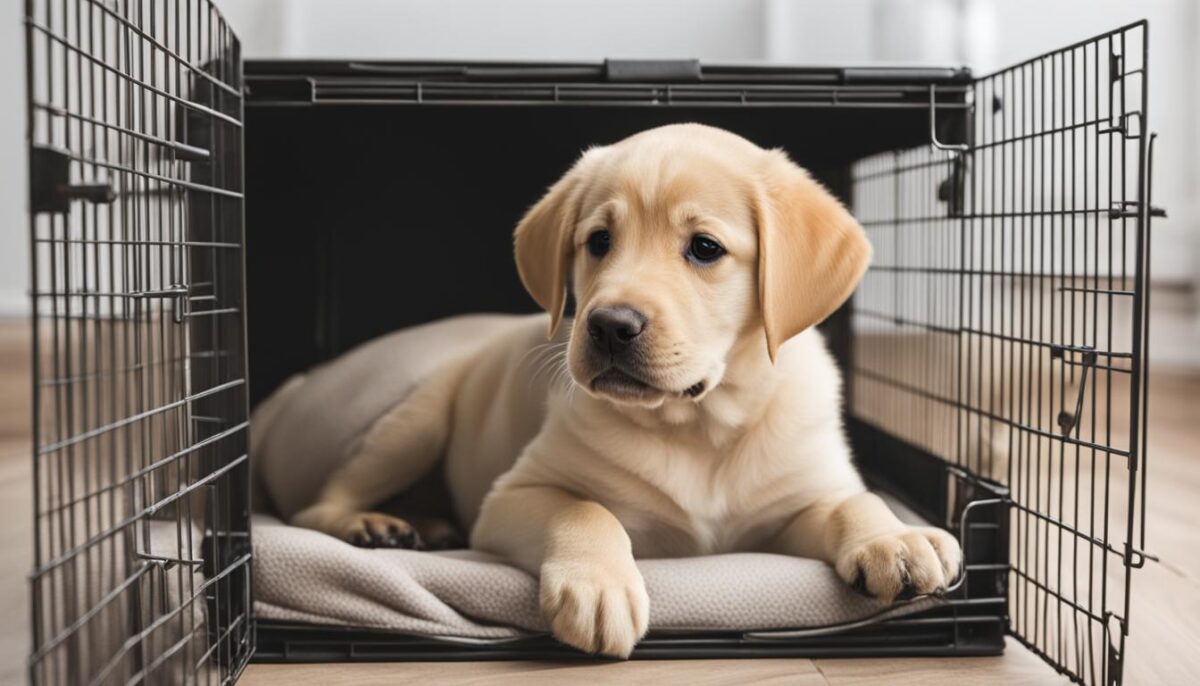Have you ever thought about how to make your puppy happy with a crate? You might be surprised to learn that a crate can be a safe space for dogs. It’s like their own room with a comfortable dog bed to snooze on. Think of it as a cozy spot where they can relax. It’s a great way to help with dog behavior management. If you’re starting with puppy crate training, remember, it’s not for being mean. It’s to keep them safe and to teach them good manners using treats and love.
Key Takeaways
- Crate training creates a safe and happy place for your dog.
- Using a crate helps teach your dog good behavior in the house.
- A comfy bed inside the crate makes it a cozy spot for your puppy.
- The crate is not for punishment – it’s a place for your dog to feel secure.
- Treats and patience are key when starting puppy crate training.
- Remember, the crate is like your dog’s own special room at home.
Understanding the Basics of Crate Training
Crate training your dog is like giving them their own special room. It’s a cozy spot where they can relax and feel safe. Imagine having a small fort made just for you!
The Purpose of Crate Training: Safety and Comfort
When dogs have their own little space, like a kennel, it makes them feel safe. It’s their safe corner to hide when they feel scared. It helps stop them from feeling dog anxiety and acting in ways we don’t like. It’s because it makes them think of a den, which for dogs, is the best hideout!
Choosing the Right Crate for Your Dog
Finding the best dog crate is a bit like picking the right size shoes for yourself. You wouldn’t want them too big or too little! Crates come in all styles – some are made of wire, some look like little houses, and some you can fold up! The right crate size is one that allows your dog to stand up and turn around, but not too big that they don’t feel snuggled up. If you have a puppy, you can get adjustable crates that grow with them. Cool, right?
Establishing a Positive Crate Environment
Now, you want your dog to love their crate, right? So, start with tasty treats and happy words when they try out their new space. That’s positive reinforcement. Make mealtime fun by feeding them in their crate. It makes the crate a happy place!
Some dogs like their crates to have soft crate bedding to curl up on. Others just want something simple. Just watch what makes your doggy happiest.
Remember, making crate time enjoyable crate time is a big goal! And the best part? This can help your dog behave better and make everyone happier. So, pick out the coolest pet supplies for their crate, and make it the best spot in the house for your furry friend!
How to Crate Train a Dog: A Step-by-Step Approach
Starting with crate training steps is key to helping your dog love their crate. First, let’s make that crate a fun place! You can begin by putting dog treats and toys inside the open crate. Let your dog check it out with no stress. This is like saying, “Hey, cool stuff happens here!”
Next up, it’s feeding in crate time. This is a big deal. While your furry friend is enjoying their meal, they are making positive crate associations. It’s like having a pizza party in their own special fort – yum and fun!
Slow and steady does the trick. Have them hang out in the crate for just a bit, and stay close. They’ll be thinking, “I’m safe, my human’s here,” and that feels good. Little by little, increase crate time, toss in some more dog treats, and sprinkle on the praise. They’ll be feeling great about their crate before you know it.
After a while, when they’re all comfy for about 30 minutes, you can try stepping out. Remember, it’s all about how your dog feels, so if they’re cool, you can start crating when you pop out for errands, or during bedtime. Always come back to happy tail wags and tell them they’re awesome – because they are!
Here’s a super simple list to remember the steps:
- Place treats and toys in the crate – no forcing, just fun.
- Mealtime in the crate – link yummies with the crate.
- Begin short crate sessions with you nearby – boosts trust.
- Gradually increase crate time – patience is key.
- Start crating when away – return with love and treats.
And that’s how you do it, one step at a time, with loads of love, patience, and treats!
Addressing Common Crate Training Challenges
If your furry friend starts crate training whining or showing crate training anxiety, it’s important to know that this is pretty normal. Puppies especially might whine at night because everything is new to them. Sometimes they whine because they need to go potty. Other times, they might just be trying to see if they can get your attention. The important thing is not to rush over every time they whine, or they might think whining is a good way to get you to come. If you think your dog is lonely or scared, a dog behavior specialist can give you tips to help them feel better.
Let’s talk about how long your dog or puppy should stay in their crate. There are crate time limits because staying in a crate for too long isn’t good for a dog’s body or mind. Puppies have little bladders and a lot of energy, so they shouldn’t be in crates for more than a few hours. Bigger dogs can stay in a bit longer, but they still need plenty of time outside their crate to run and play.
It’s super important that your dog feels cozy and happy in their crate, which we like to call canine comfort. You can help them love crate time by giving them special dog toys just for when they’re in the crate. One fun idea is to freeze a KONG toy with peanut butter inside so they have a yummy puzzle to solve while they hang out in their crate. Always make sure when they’re in the crate, they don’t have a collar on, so they don’t accidentally get stuck on something.
Overall, think of your dog’s crate like their own little room where they can relax and feel safe. You can make it extra comfy with a soft bed and some of their favorite toys. And remember, you’re doing crate training to help your dog learn and grow, not as a punishment. With your help and some tasty treats, your pup can start to see their crate as a chill spot just for them. That’s what we call crate enjoyment!
Dealing With Whining and Separation Anxiety
Whining might make you feel sad, but it’s pretty normal when dogs are getting used to a new thing like being in a crate. If your dog is upset when you’re not around, they might have separation anxiety. This is when they feel really scared and lonely without you. If this happens a lot, you might want to talk to a dog behavior specialist for help.
How Long Should Your Dog Spend in the Crate?
We have to be careful not to leave our dogs in their crates for too long. Puppies are just little and need to go out for bathroom breaks often. For adult dogs, the crate isn’t a place to stay all day; they need time to stretch their legs, play, and hang out with you.
Ensuring Your Dog’s Happiness in the Crate
To make sure your dog feels super happy in their crate, give them fun toys and maybe play some gentle games with them. Watching them with a camera when you’re not home can help you see if they’re okay, and you can make any changes to make them even happier.
Conclusion
If you’ve been following our guide, you’re on your way to successful crate training. Remember, the crate is a special place for your dog. It gives them their own space to feel safe and happy. You’re helping your dog learn and grow, which is a big deal! With each step, take your time and be kind. Your dog will get better each day.
The most important thing in crate training is to be patient. Be consistent, too. This means doing things in the same way so your dog can learn what you expect. Using the crate in the right way is all about making sure it’s an enjoyable dog space. And when you meet a new challenge, it’s cool – you’ve got the know-how to handle it.
By using these tips, you can make sure your dog feels great and behaves well. This makes everyone in the home feel good. All in all, crate training is about more than just a crate; it’s about giving your furry friend the comfort and security they deserve. And that leads to a much happier life together for you and your dog!
FAQ
What is the purpose of crate training a dog?
The purpose of crate training is to provide a safe and comfortable space for your dog that can prevent mishaps and improve behavior. It aims to satisfy their instinctual need for a den-like environment, thus reducing anxiety and promoting a calm demeanor.
How do I choose the right crate for my dog?
Select a crate that is sturdy and the right size for your dog. It should not be too large or too small, and it’s best if it can accommodate your dog’s adult size. Consider wire crates for durability, plastic kennels for more privacy, or fabric crates for portability. Adjustable crates with dividers can grow with your puppy.
How can I establish a positive environment in the crate?
Introduce the crate with positive reinforcements like treats, toys, or praise to build a happy association. Consider the type of bedding your dog prefers, whether it’s a soft bed or a simple crate mat, to make it a place they want to retreat to.
Can you outline the basic steps for crate training?
Start by introducing the crate without pressure, using treats or toys to make it enticing. Progress to feeding your dog inside the crate, and eventually, start short confinement periods with you nearby. Gradually increase the time they spend in the crate until they are comfortable being in it while you’re away or overnight.
How do I deal with whining or separation anxiety during crate training?
Identify whether the whining is due to a need, like going outside, or if it is a test of boundaries. Avoid reinforcing whining with attention but instead address the behavior consistently and calmly. For dogs with separation anxiety, crate training may not be sufficient, and seeking a behavior specialist’s advice may be necessary.
How long should my dog spend in its crate?
The crate should not be overused; puppies especially should not be confined for too long due to their need for frequent breaks and socialization. Limit crate time to a few hours and ensure it’s a positive experience with enough breaks for exercise and bathroom needs.
How can I ensure my dog is happy in its crate?
Ensure the crate is a rewarding space by using treats, like frozen stuffed KONG toys. Play crate games and maintain a safe space with a “naked” policy—no collars or tags inside the crate. Monitor their time and comfort levels, possibly with a remote camera, and adjust the training as needed to ensure they view the crate positively.
What should I avoid doing when crate training my dog?
Avoid using the crate as a form of punishment. Never force your dog into the crate and do not leave them confined for excessive periods. Always ensure crate time is associated with positivity and safety.


